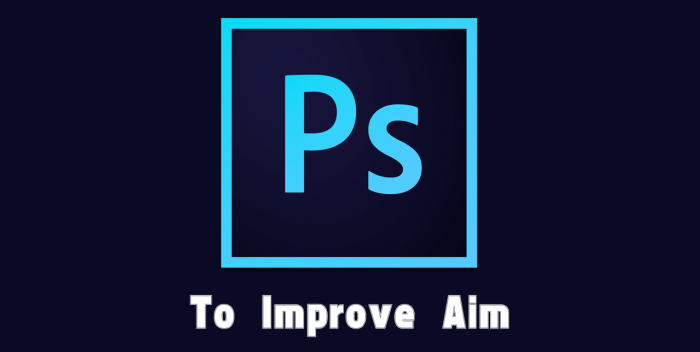Get Good: Five unconventional ways to improve your gameplay
The ways to improve your aim, keystroke precision, timing, almost any mechanical aspect of your game, they’re well documented and you’ll find them everywhere. For shooters, spend time aiming for headshots; MOBAs, practice your command accuracy; RTS’s, drill yourself on keystroke precision. I’ve offered similar advice myself, but there are other ways to up your skills, many of them doing the very things you spend your days doing.
Improve your aim: use Photoshop
This first tip goes out to all the graphic designers in our readership, and even to those who aren’t. Photoshop is, I think, a must have program if you spend any significant amount of time on the computer, if only because it can give you an appreciation for the complexities of design. That said, there’s a simple action that could do wonders for you aim, either in shooters lining up the perfect headshot or in MOBAs in picking out the perfect spot for an AoE ability.
The idea is this: learn the basics of Selecting with the Quick Select and Lasso tools, and spend time trying to accurately trace finer details in images. If you already do graphic design, you should be getting where I’m going with this. If you can precisely select an area of an image without having to do too much revision to that selection, your mouse control is already quite high. If you need to go back and reselect-deselect-reselect, you need to work on your mouse control. Again, designers already do this, and while the correlation between snapping to a target and exactly highlighting an area in an image isn’t perfect, it’s there.
Once you master this ability, you’ll see a marked result. You aim will likely be smoother, and when you do snap to where you want to shoot/cast, you’ll be better equipped to stay there. And when your target moves, you’ll be better able to track him. Half the battle in a firefight is staying on target once you have one, and if you can easily adapt to your enemy’s shifting movements, he’s far easier to take down.
Improve your peripheral vision: throw a ball
I don’t mean the party-kind-of-ball, of course. I’m talking about a little stress ball, something with some heft to it. It needn’t even be a ball, and can be something you commonly hold that weighs a couple pounds, so long as it’s safe to toss up and down. The idea here is this: when reading, watching a video, staring at a screen filled with data, whatever, toss the ball up in the air and try to catch it.
The trick is, don’t watch it fall. Keep looking at the book or TV screen or monitor and try to position your hand based only on your peripheral view of the item you’re throwing. Oftentimes, the most crucial bits of information aren’t in front of you, or even close to either side. Rather, they’re at the edge of vision, easily missed if you aren’t looking out for them. And you aren’t always looking out for enemies, either. Some valuable supply might be cleverly hidden away; an ally might appear for just a moment, in dire straits against some threat. Or maybe your eyes are at the other corner of the screen, and what you would have otherwise easily seen is now in the periphery. It doesn’t matter which is the case, if you’ve trained your peripheral to catch small movements and details, you’ll be better equipped to fight.
This strategy has the side effect of working on your motion prediction. If you can’t see your hand, you have to predict where precisely the ball will land, and that’s not always an easy feat.
Improve your motion prediction: watch a sport with a ball involved
Wonky camera angles aside, ball sports are always a matter of prediction. The quarterback doesn’t throw where his teammate it: he throws where the teammate’s about to be. A soccer/football player doesn’t kick towards where the goalie isn’t, he kicks towards where the goalie won’t think to block. And so on. Your job as the viewer is not to think like the quarterback or the goalie or the player at all. Think about the ball. Try to see if you can predict, shortly after the ball starts flying, whether it will do what the thrower/kicker/hitter wanted it to do.
The earlier you can correctly predict success or failure, the better you’ll be able to hit long range moving targets. For example, the best Team Fortress 2 Soldiers, Demomen, and Medics shoot where their targets are going to be before they get there, and the Sniper aims the headshot where the head will be, not where it is. They know, based on the speed and trajectory of their target where it’ll be in the next few seconds, and they plan their shots accordingly. Like shooting clay pigeons out of the air, they’ve mastered the timing of their projectile and how their enemies move. Watching, and correctly predicting, where a ball will go before it gets there is much the same.
As might be expected, this skill is tightly woven with you aim, and the two should be practiced in tandem whenever possible. If no computer’s handy, you can try tracing with your fingers on the surface of whatever you’re sitting on, and if standing try tracing on your arm. You might look funny, but it’s better than nothing.
Improve your threat prediction: have a conversation
Or more correctly, an argument. I don’t condone starting meaningless fights, nor do I think you should disagree for the sake of it (unless that’s your thing), but if you get into a heated discussion, try to practice predicting where the next jab’s going to come from. Like the Photoshop example, the correlation here isn’t a firm one, but verbal exchanges share much in common with a confrontation between two players in a video game. In real life, debate focuses around argument, support, rebuttal, and half the battle is in predicting what the rebuttal will be. Formal debating is perhaps the best method of practicing threat prediction, but if you have a spouse, girlfriend, good friend who you sometimes come into conflict with, practice threat prediction.
It’s all about coming from where they don’t expect and hitting hard. You have to see the flaws in their strategy just as they see the flaws in yours, causing a back and forth that plays out in the mental space rather than in cyberspace. Still, if you can learn to anticipate where the next unseen attack is coming from, you’ll be better equipped to deal with unexpected threats.
Improve your enjoyment: give yourself options
More a metaphysical pursuit in life than one you can physically do, I think the concept works. The great thing about gaming nowadays is, there are so many different genres and ways to play. If your MOBA of choice is getting you down, jump into an open world and work out the kinks in your shoulders. If you can’t find another good Skyrim mod to save your life, try hopping in a racing sim or, god(s) forbid, a JRPG. And if nothing strikes your fancy at all, all three consoles and PC offer an innumerable amount of time-sucking distractions that a sometimes are completely free.
Like, for example, reading an article on TopTierTactics.








To kinda expand upon what you were saying about predicting what your opponent will do. If your playing any game and you’re use to playing a certain role. Wether it be a sniper in call of duty or a ADC in League of Legends or Smite. Try playing the role that you have trouble against, the goal will be to learn what it takes to get kills or what it takes to be killed.
Then you should be able to take that knowledge back to role you originally started with and know wether you should go in by yourself or wait for your teammates. It pays dividends to know if your gonna need to two shots to kill someone or three.
Great article. My only problem with Photoshop is that I play invert mouse in most games, so I learn the opposite of my normal input using Photoshop!
[…] reading Xiant’s recent piece on unconventional ways to improve your gameplay, I spotted something which just didn’t seem right. It struck to the very core of my being, […]
[…] After collecting enough animal pelts to make a big game hunter queasy, you’ll probably have an itch to shoot something. There isn’t much to the gunplay in Far Cry 3, sad to say. You point at things and click till they die. Like its predecessor, bullet travel time is instant from any distance, so it comes down to your skill with the sticks/mouse and keyboard. The weapons are satisfying to use and each feels different from the last. Most are fully customizable, and more unlock as the story progresses. But unless I write a “How to improve your aim in an FPS” article sometime down the road, I can’t give much more than that (And just so we’re clear, I actually did). […]